VoIP Integration Into CRM Apps: The Ultimate Guide [2025]
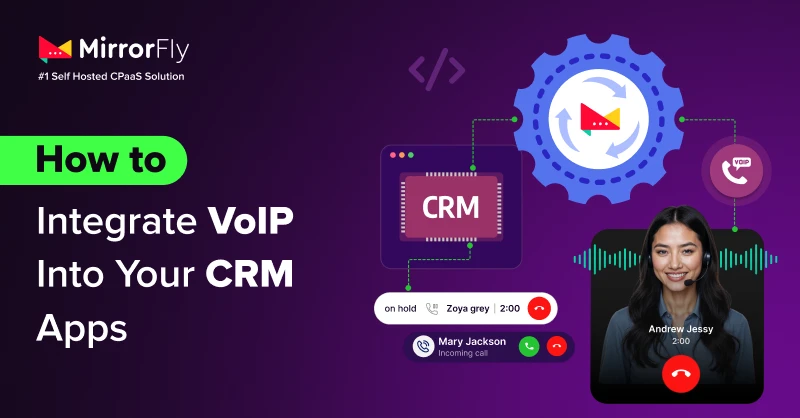
Combining VoIP & CRM comes with the biggest benefits:
- Your user conversion will increase by 283%
- Operational cost of your platform will go down by 77%
- The time taken for 1 call can be reduced by 39%
Integrating VoIP calls into your CRM software helps your teams to access user data and make calls from one place. They need not juggle between apps. Rather, they can find a customer’s past interactions, their preferences along with other important call details in real-time.
This is a big transformation, especially in customer support operations.
Going ahead, this article will discuss – what is VoIP integration and its benefits in detail. You’ll also learn about the top VoIP CRM integration softwares in the market to help you get started.
Table of Contents
CRM With VoIP Integration: What You Need to Know?
VoIP integration means linking your internet-based phone system with other (or external) business tools. In this scenario, the business tools refer to CRM (Customer Relationship Management) platforms.
So, how exactly is this done?
You can rewrite the source code of your platform to connect these two technologies. However, the complete code amendments, testing and launching would consume a few months and pretty-much a lot of resources.
Instead, you can use API – Application Programming Interface, which gets it all done within a coffee break!
In the next section, we will discuss how exactly this is done!
How Does VoIP CRM Integration Actually Work (With An API)?
The goal is to connect your CRM software to your VoIP system so they can exchange real-time data and make things easier for you. To achieve this, you’ll need an API, a reliable one like MirrorFly that can act as the interface between both the systems.
There are 2 scenarios here. 1.You use your own VoIP app, 2. You are just starting to build a VoIP app for your team, 3. You are already using a third-party VoIP platform.
Using an API to perform this integration will work for the first two scenarios. The third scenario is out of hand and depends on the app’s compatibility with third-party extensions or plugins.
📌 Now, let’s focus on the first 2 scenarios.
1. You use your own VoIP app
This is almost perfect as you’ll have your source code you can play with. You’ll just need to invest in a reliable API that allows you to connect your app with a CRM.
2. You are just starting to build a VoIP app for your team
This is a perfect scenario, as you have the freedom to customize both VoIP and CRM according to your workflow, right from the start. This can be done even more seamlessly with providers like MirrorFly that offer APIs to build your own VoIP systems along with CRM integrations.
This is a perfect scenario, as you have the freedom to customize both VoIP and CRM according to your workflow, right from the start. This can be done even more seamlessly with providers like MirrorFly that offer APIs to build your own VoIP systems along with CRM integrations.
Whichever VoIP platform you use, this is how you can achieve the integration:
Step 1: Selecting your CRM platform
Given the aforementioned scenarios, you already have a VoIP system (either active or in the building). This means, you’ll need to choose your CRM platform that can take care of all your customer data efficiently and connect with your calling system.
Step 2: Linking VoIP + CRM using an API
Once you are ready with your VoIP source code and have a selected CRM, use the API to connect them both using authentication keys. They set up the endpoints and adjust the configurations so both systems can communicate with each other.
Step 3: Allowing Data Sync
Once connected, the API passes call information to the CRM automatically. This can include:
- Time of call (Connect time and Disconnect time)
- Caller identity (mapped with CRM contacts)
- Call duration
- Notes taken during the call
- Call recordings (if enabled)
Step 4: Setting Up Click-to-Call & Caller Details
After integration, you can place the option in your CRM to make calls from the platform directly rather than having to use a separate app. When receiving a call, the CRM displays available information about the caller pulled from past interactions and call records that are stored in your system.
Step 5: Trigger CRM Actions Based on Call Events
Besides click to call and caller details, the API can also be used to automate actions in the CRM. You can easily create rules to follow-up tasks for missed calls, log completed calls, or send messages after a call ends.
So, that’s how easy it is to set up the VoIP CRM integration and helpful to automate everything that requires so much manual work.
Top CRMs You Can Easily Integrate with VoIP
1️⃣ Salesforce
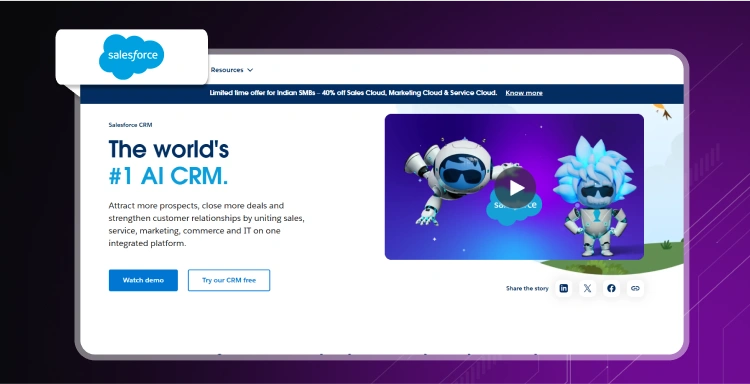
Salesforce is a powerful, cloud-based CRM tool that helps big businesses keep track of leads, sales opportunities, and customer relationships.
When paired with a VoIP system, it automatically logs every call, saving details like how long the call lasted, when it happened, and what the outcome was. That means no more manually entering call info.
- Pricing: $25 – $300 per user/month (billed yearly)
- Best for: Large companies that need a CRM with tons of customization options.
2️⃣ HubSpot
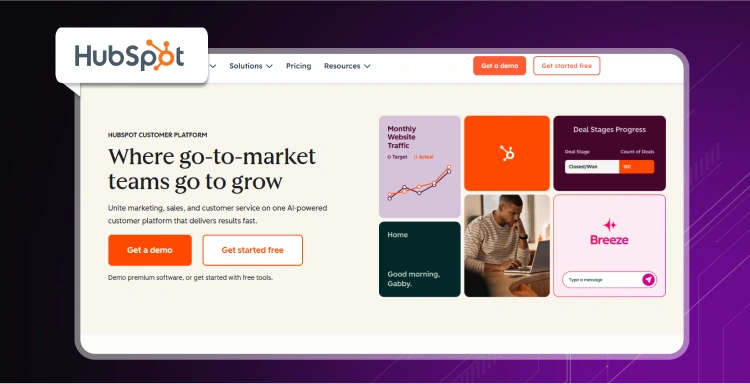
HubSpot brings your sales, marketing, and customer service together in one platform.
You’ll have a built-in VoIP integration, so you can make calls, log conversations, and follow up without having to leave the CRM. It’s simple, smooth, and saves time.
- Pricing: Free plan available; paid plans start at $45 and go up to $3200 per month
- Best for: Growing businesses looking for an all-in-one CRM.
3️⃣ Pipedrive
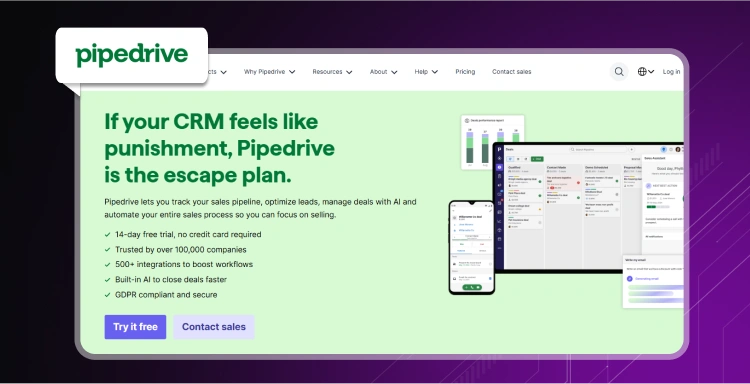
Pipedrive is built specifically for sales teams. It helps them see and manage their sales pipelines more clearly.
When you connect it with VoIP, agents can make calls directly from their CRM dashboard, automatically log the call, and follow up. Overall, it is less tab-switching with Pipedrive as a CRM partner.
- Pricing: $12.50 – $99 per user/month (billed yearly)
- Best for: Sales-focused teams who want a simple, user-friendly CRM.
4️⃣ Zoho CRM
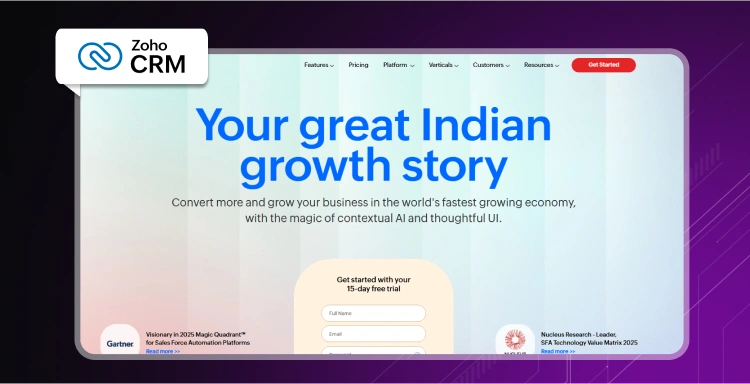
Zoho CRM is a popular and flexible system that handles sales, marketing, and support. It works well with popular VoIP providers like RingCentral, Vonage, and 8×8.
Setting up Zoho is actually as easy as if you are adding a browser plug-in to your app or using a simple API.
- Pricing: $12 – $45 per user/month (billed yearly)
- Best for: Small to mid-sized businesses that want a scalable solution with a full suite of tools.
5️⃣ Zendesk Sell

Zendesk Sell helps sales teams work more efficiently by giving them clear visibility into their pipeline and automating common tasks that usually takes too many hours when handled manually.
Its VoIP integration lets agents call or text customers straight from the platform.
- Pricing: $19 – $99 per user/month (billed yearly)
- Best for: Customer service and support teams that want a simple, integrated CRM.
So, these are our top picks when it comes to a CRM. Now, considering you are in scenario 2, building your VoIP app, here are some of the most developer-friendly VoIP providers that can help you build your VoIP app in almost half the budget of building it from scratch.
What Can You Do with a VoIP CRM Integration?
✔ Keep Everything in Sync Automatically
VoIP CRM integration keeps your phone system and customer software working together without you having to lift a finger.
Any time a call comes in or goes out, the details like who called, when, how long it lasted, and which contact it was are automatically saved in your CRM. This happens in the background, often in real time, so your customer records, notes, deals, and tags are always up to date.
✔ Call Straight from Your CRM
With click-to-call, you can make a phone call by just clicking a number inside your CRM. This avoids dialing mistakes and saves time since you don’t have to switch between apps or manually type in phone numbers.
✔ Review Calls Instantly
Once a call ends, you can easily find the recording and any notes right inside the CRM. You don’t need to search for files or log anything manually.
It’s all saved automatically, which helps agents wrap things up quickly and stay organized.
✔ See Caller Info the Moment They Call
When someone calls, a pop-up instantly shows who they are and their full history with your business like past orders, open support tickets, and previous interactions.
This real-time customer card lets agents jump right into the conversation with context, without digging for details.
✔ Track Call Center Performance
Your CRM can also show you useful reports about your call activity like how many calls are coming in, how long they last, how often calls are missed, and how quickly issues get resolved.
These insights help teams spot what’s working and where improvements are needed.
✔ Set Up Smart Automations
The system can take action based on what happens during a call. For example, if a call is missed, it can automatically create a follow-up task.
If the call goes well, it might send a survey or email. You can also use it to send automated text messages when certain conditions are met, making follow-ups faster and more consistent.
Top VoIP Providers That Support CRM Integration
1️⃣ MirrorFly
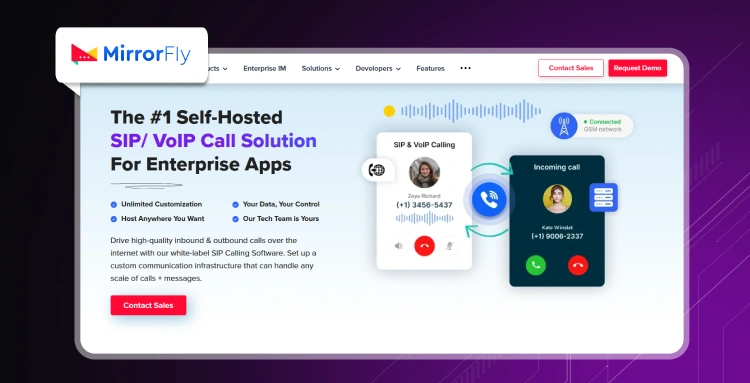
This communication platform (CPaaS) lets you add voice, video, chat features, activity feeds, AI agents, live streaming and 1000 more features to your app, without breaking a sweat.
All of its communication functions are powered through its APIs and SDKs that are 100% customizable and white label. With MirrorFly’s VoIP calling solution, your teams can route calls to mobile devices, websites, or SIP domains, and manage calls efficiently with advanced monitoring tools.
The best part is – there is no restriction on where you deploy your app. You can host it on-premise, on MirrorFly cloud or anywhere you name it.
- CRM Integration: Offers API-based integration, with custom security encryptions
- Pricing: Available at custom pricing if you prefer to self-host your app. On the other hand, if you’d like to go with a monthly subscription, their essential package starts at as low as $0.08 per user/month (pay-as-you-go).
- Best For: Businesses that need secure, customizable communication solution with an API-first approach
2️⃣ JustCall
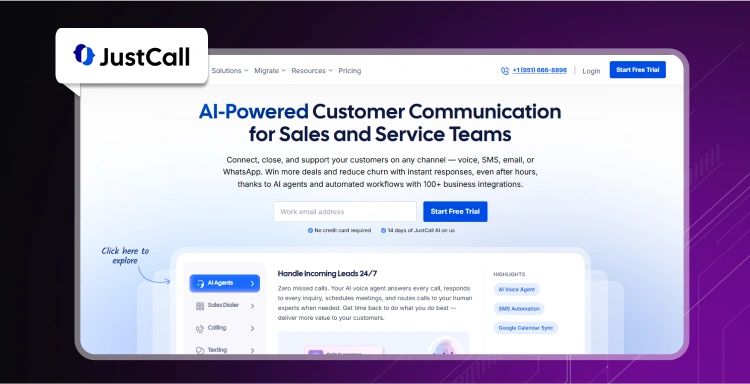
JustCall is specifically designed for busy sales and support teams. It connects directly with CRMs like Pipedrive and Copper, automatically logging calls and syncing details in real time.
You get call duration, outcomes, and notes without having to manually save them.
- CRM Integration: Native integration with popular CRMs like Pipedrive and Copper
- Pricing: Varies by plan. Contact JustCall for full pricing details
- Best For: Sales and support teams that want easy, ready-to-use CRM integrations
3️⃣ FreJun
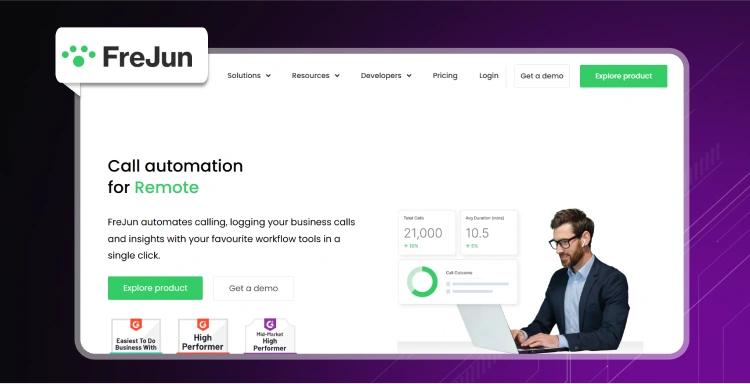
FreJun (or Frejun) offers AI-powered VoIP solutions with features like virtual numbers, auto-dialing, transcription, and call recording.
It has built-in CRM/ATS integration, especially with Pipedrive and HubSpot, automatically logging calls and delivering detailed analytics. It also includes tools like IVR, auto-logging, and 24/7 customer support.
- CRM Integration: Native support for Pipedrive and HubSpot, with smart call tracking and automation
- Pricing: Starts at $4.99/month, offering affordable plans for smaller businesses
- Best For: Small to mid-sized businesses that want affordable, AI-driven communication tools with CRM integration
4️⃣ Dialpad
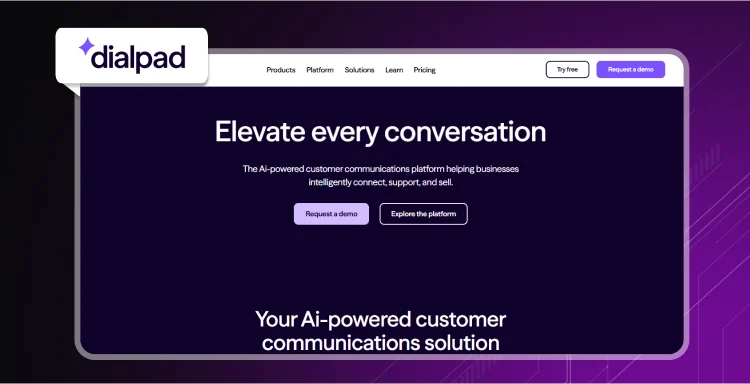
Dialpad is a cloud communication platform designed for tech-savvy businesses.
The platform offers easy integration with major CRMs and features like automatic call logging, real-time customer data updates, and built-in AI tools for better call handling and insights.
- CRM Integration: Direct connectors to platforms like Salesforce, HubSpot, and Zoho
- Pricing: Starts at $15 per user/month (Standard plan)
- Best For: Businesses that want reliable VoIP with strong AI features and CRM syncing
5️⃣ 8×8
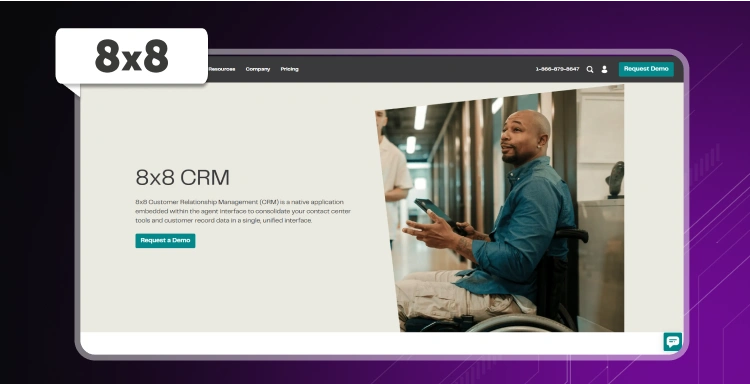
8×8 provides a cloud VoIP system that works well for businesses of all sizes, especially those with global teams. It integrates with major CRMs like Salesforce, Zoho, HubSpot, NetSuite, and Zendesk.
The API supports real-time syncing, call tracking, click-to-call, and detailed reporting through its API tools.
- CRM Integration: Supports many top CRMs out of the box, with customizable API access
- Pricing: Starts at $25 per user/month, with a 30-day free trial
- Best For: International businesses or those needing a full-featured, enterprise-level communication system
5 Benefits of Using a VoIP CRM Integration
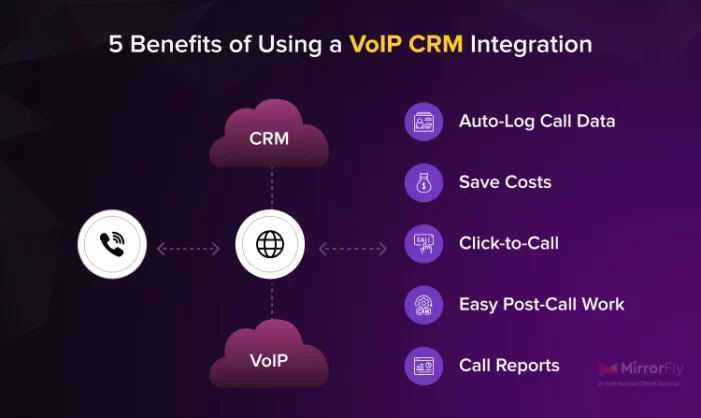
1. Automatically Collect Customer Call Data
VoIP CRM integration helps you collect important customer info without doing it manually. Every time someone on your team makes or receives a call, the system logs details like how many times they called, whether the call was answered, and how long it lasted.
It also tracks SMS messages, adding them directly to the customer’s file in the CRM so your sales team doesn’t have to do anything extra.
2. Cut Down on Costs
Using a VoIP phone system that works with your CRM can save your business money. You don’t have to pay for two separate tools because the integration combines everything into one solution.
It also cuts down on manual work, which means your team can focus on more valuable tasks. In fact, companies that invest in CRM systems usually see a strong return of about $8.70 back for every $1 spent.
3. Click to Call Right from the CRM
With click-to-call, agents can start a call by clicking a customer’s phone number directly in the CRM. No more typing in numbers or jumping between screens.
Everything is in one place: customer info, the call button, and automatic logging of the call details.
4. Post-Call Work Made Easy
After a call ends, the system automatically saves the recording and any notes into the CRM.
It can also trigger follow-up actions based on the call like creating a task if someone missed the call or sending a survey if the conversation was completed. That means less admin work for your team.
5. See What’s Working with Call Reports
You can track call stats directly in your CRM, like how many calls are happening, how long they last, how many are missed, and how quickly issues are resolved.
These insights help you see how your team is doing and where there’s room to improve, whether it’s sales or customer service.
Editor’s Recommendation
If you’ve come this far, it truly means you are quite serious about the VoIP CRM integration for your business. We hope this article helped to gain the most of what you need to know about both the technology and how to integrate them. This is a basic coverage of the process, on the whole. Now, if you’d ask what we’ll pick for a VoIP provider, we’ll undoubtedly pick MirrorFly for you.
The solution is fully customizable and is suitable for both the scenarios – adding VoIP to existing apps or building one anew. It gives complete data sovereignty and supports custom security features above its built-in AES encryption, GDPR, HIPAA and OWASP. You can also customise it to be compatible with region-specific regulations.
And if you think you need a hand to do all of the integration, you can quickly hire their team of experts who’ll handle the process end-to-end. If you are already impressed with this highly-awarded solution, check out MirrorFly’s quick demo to experience it yourself and have things started!
We hope this post has done its purpose. If you have any questions, please feel free to write down in the comment section below and our team will be more than happy to answer them!
FAQ
VoIP (Voice over Internet Protocol) integration is the process of combining or integrating VoIP applications and services with other business systems, such as CRM, ERP, real-time communication apps, or with existing infrastructure. With this integration, organizations can enhance customer service and utilize comprehensive features such as click-to-call, voicemail-to-email transcriptions, and other advanced capabilities.
VoIP CRM integration is a process of connecting VoIP phones with customer relationship management software, where all basic information is automatically synced. Through this integration, features such as call logging, call recording, caller ID recognition, and click-to-call capabilities are available via the CRM dashboard.
CRM integration is a simple process of connecting your CRM (Customer Relationship Management) software with any third-party app or software. With this integration, your app’s functionality will be improved, thus eliminating the need to toggle back and forth between different systems.
No, a CRM is not an API as CRM is a customer relationship management software which is a system to manage interactions with customers in an effective way and market sales, generate leads, and do more. However, certain CRMs offer API features to integrate with other apps.
A CRM is a customer management tool used to manage all interactions with users, market products, send promotions, and gain detailed insights into any campaign run. However, VoIP, on the other hand, is a technology that enables businesses to make voice calls to customers over the internet, eliminating the need for traditional phone lines.
In order to integrate VoIP solutions into your CRM application, you must choose a third-party provider like MirrorFly or Apphitect who offers VoIP APIs and SDKs, with which you can seamlessly add all features of VoIP into your CRM software.
Here’s what you should to choose the best VoIP provider:
- Define the VoIP needs
- Analyze what is your budget
- Do a complete research on VoIP providers and draw a comparison
- Check out their pricing and see a free demo
- Get quotes
The cost to integrate CRM with VoIP software completely depends on your CRM platform and the VoIP service provider that you choose. Because, some of the customer management platforms offer easy integrations, while others require additional platforms and customization.
Want to Integrate VoIP into your CRM Within 48 hrs?
We’ve built a selfhosted video, voice, meeting, video KYC, feed, SIP & chat solution just for you. Get 1000+ in-app features, unlimited customization & host on your own server.
Contact Sales200+ Happy Clients
Free Migration
Multi-tenancy Support
